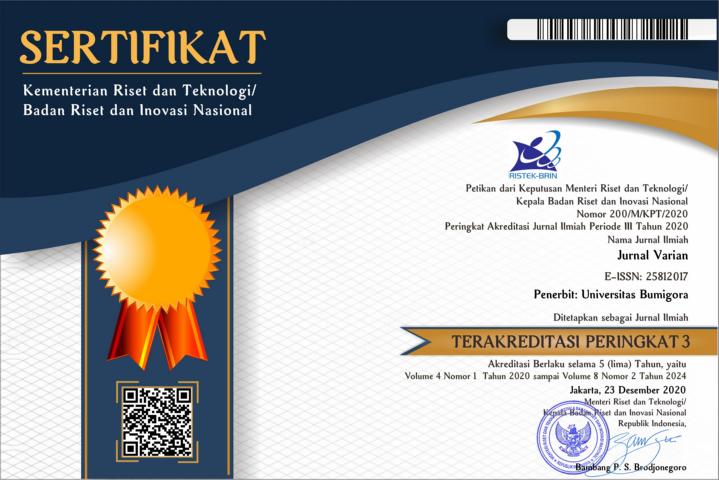Analysis of User Satisfication with Graduates in Statistical Study Program Universitas Terbuka
Abstract
Revolution 4.0 requires the Universitas Terbuka Statistics study program to change the educational curriculum that aims to produce quality graduate competencies. Therefore, to collect informationand evaluate the competence of graduates, it is necessary to conduct tracer study research on each graduate. This study aims to measure user satisfaction with graduate competencies using Gap analysis, Importance-Performance Analysis (IPA), Customer Satisfaction Index (CSI), and a multi-attribute Fishbein model. Based on the value of Gap and Science, the main priority that must be improved by graduates to meet user expectations is the ability to solve problems, generate ideas, and be able to present the results of these ideas in the form of reports/journals. The value of the level of suitability between user satisfaction and the importance of the ability of graduates is very good at 92.87% and a CSI value of 78.25%, which means that overall user satisfaction with graduates is good, besides thatbased on the results of the multi-attribute Fishbein model, an Ao value of 158.20 which means that graduate users have a positive attitude towards the abilities of UT Statistics program graduates.
References
Online Learning: Using Evidence and Theory to Improve Practice. Journal of Computing in Higher Education, 23(2-3):82–103.
Arabia, S. (2021). The Satisfaction Level of Undergraduate Science Students Towards Using E-Learning and Virtual Classes in
Exceptional Condition Covid-19 Crisis. (January):52–65.
Feng, M., Mangan, J., Wong, C., Xu, M., and Lalwani, C. (2014). Investigating The Different Approaches to ImportancePerformance Analysis. Service Industries Journal, 34(12):1021–1041.
Fidalgo, P., Thormann, J., Kulyk, O., and Lencastre, J. A. (2020). Students’ Perceptions on Distance Education: A Multinational
Study. International Journal of Educational Technology in Higher Education, 17(1).
Jasuli (2018). Analysis of Student Attitudes Towards E-Learning Using Fishbein Multiattribute Approach. IOP Conference Series:
Materials Science and Engineering, 296(1).
Kumari, P. (2020). Comparing Customer Attitude Towards Amazon and Flipkart in Patna. International Research Journal on
Advanced Science Hub, 2(Special Issue ICSTM 12S):4–8.
Kumi-Yeboah, A., Kim, Y., Sallar, A. M., and Kiramba, L. K. (2020). Exploring The Use of Digital Technologies From The
Perspective of Diverse Learners in online Learning Environments. Online Learning Journal, 24(4):42–63.
Lassoued, Z., Alhendawi, M., and Bashitialshaaer, R. (2020). Education Sciences An Exploratory Study of The Obstacles for
Achieving Quality in Distance Learning During The. Education Sciences, 10:1–13.
Lubis, S. N., Fauzia, L., and Utami, D. (2020). CSI (Customer Satisfaction Index) and IPA (Importance Performance Analysis) of
Mandheling Coffee in Medan. IOP Conference Series: Earth and Environmental Science, 454(1).
Peraturan Menteri Pendayagunaan Aparatur Negara Dan Reformasi Birokrasi Republik Indonesia (2017). Pedoman Penyusunan
Survei Kepuasan Masyarakat Unit Penyelenggara Pelayanan Publik.
Picciano, A. G. (2017). Theories and Frameworks For Online Education: Seeking An Integrated Model. Online Learning Journal,
21(3):166–190.
Prodi Statistika (n.d.). http://fst.ut.ac.id/index.php/statistika-s1/.
Renny, Chandra, R., Ruhama, S., and Sarjono, M. W. (2013). Exploring Tracer Study Service in Career Center Web Site of Indonesia
Higher Education. 11(3):36–39.
Silva, F. and Fernandes, P. (2010). Using Importance-Performance Analysis in Evaluating Institutions of Higher Education: A
Case Study. ICEMT 2010 - 2010 International Conference on Education and Management Technology, Proceedings, (January
2014):121–123.
Taber, K. S. (2018). The Use of Cronbach’s Alpha When Developing and Reporting Research Instruments in Science Education.
Research in Science Education, 48(6):1273–1296.
UT (n.d.). https://www.ut.ac.id/tentang-ut.
Vieira, E., Ferreira, J. J., and Sao Jo ˜ ao, R. (2019). Creation of Value for Business From The Importance-Performance Analysis: ˜
The Case of Health Clubs. Measuring Business Excellence, 23(2):199–215.
Wade, D. J. and Eagles, P. F. (2003). The Use of Importance-Performance Analysis and Market Segmentation for Tourism Management in Parks and Protected Areas: An Application to Tanzania’s National Parks. Journal of Ecotourism, 2(3):196–212.
Widayanti, S., Amir, I. T., Indah, P. N., and Septya, F. (2020). Consumer Preference of Packaged Rice and Bulk Rice in Surabaya.
HOLISTICA Journal of Business and Public Administration, 11(1):155–169.
Yanova, N. (2015). Assessment of Satisfaction with The Quality of Education: Customer Satisfaction Index. Procedia - Social and
Behavioral Sciences, 182:566–573.

This work is licensed under a Creative Commons Attribution 4.0 International License.

















